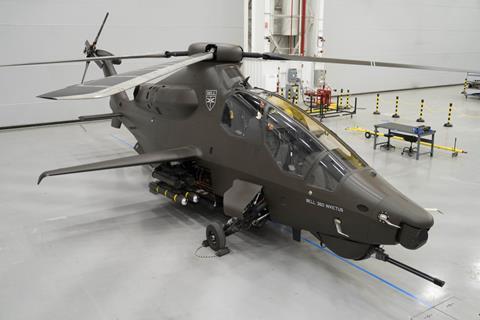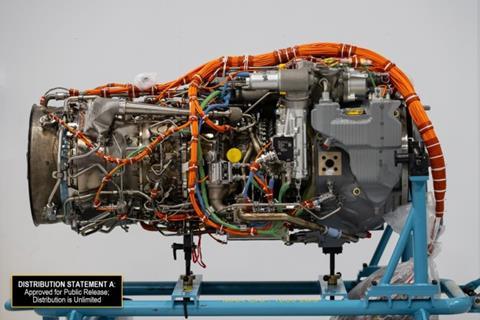GE Aerospace’s long-delayed Improved Turbine Engine (ITE) may soon be delivered to its first customers.
The US Army on 4 October said it anticipates delivering the prototype engine to helicopter makers Bell and Sikorsky, which are finalists for the service’s Future Attack Reconnaissance Aircraft (FARA) contract, sometime in the next few weeks.
“The government has accepted the first GE Aerospace T901 flight-test engine, with the second T901 engine currently going through the acceptance process,” the army’s aviation procurement office says. ”Both engines are on-track to be delivered by the government to the FARA competitive prototype vendors by the end of October 2023.”
GE delivered the first T901 to the army on 28 September, the service reveals. As so-called “government furnished equipment”, the army separately contracted with GE for the ITE, which it will then provide to Bell and Sikorsky.
Bell confirms that it expects to receive the new engine from the government sometime in October.
Sikorsky president Paul Lemmo says his company anticipates receiving its first ITE later this month.
“As soon as we receive it, we will be able to immediately start the installation process in advance of ground testing and eventually flight testing,” Lemmo says.
Delivery of the completed ITE is a critical milestone in the FARA programme – which has been largely stymied without it.
The US Army in 2019 contracted GE to produce a powerplant for its next-generation FARA programme, which will replace the long-retired Bell OH-58 Kiowa scout helicopter. GE has designated that engine the T901-GE-900.
“This engine represents the culmination of several years of working closely with the Improved Turbine Engine Program and GE Aerospace to ensure our soldiers are equipped with the best achievable equipment they need to safely fight and win,” says US Air Force Lieutenant Colonel Paul Hrad, who oversees GE aircraft propulsion programmes at the Defense Contract Management Agency.
In addition to powering the FARA competitive prototypes, the ITE will also replace the current GE T700 engine that equips the army’s Sikorsky UH-60 Black Hawks and Boeing AH-64 Apaches.

The army says the new powerplant will improve the range, loiter time and fuel consumption on the service’s fleet of legacy aircraft. The service operates a fleet of 824 Apaches and over 2,300 Black Hawks, according to Cirium data.
”The engine’s reliability and increased life expectancy also reduces maintenance and sustainment costs,” the army says of the new T901.
GE declined a request for comment on the latest development in the ITE programme.
The company has struggled to deliver the T901, suffering repeated delays it has blamed on lingering supply chain issues related to the Covid-19 pandemic. The schedule slippages have significantly delayed the first flight of both Sikorsky’s RaiderX and Bell’s 360 Invictus FARA type.
The army and its two FARA finalists had previously aimed for the prototype aircraft to lift-off in the autumn of 2023. That date already represented a one-year delay to an earlier schedule, which had competitive testing starting sometime in 2022 or early 2023.
For over a year now, both Bell and Sikorsky have reported being near completion on assembling their FARA competitive prototypes. At the Paris air show in June, both competitors said their builds were at least 95% finished.
The two FARA finalists have been conducting limited ground evaluations of their prototypes while awaiting delivery of the T901 engine from GE.
However, with the ITE delivery apparently imminent, the programme appears to be on track with the latest army schedule. In March, the army procurement office for aviation systems told FlightGlobal the service expected delivery of the ITE in “early fiscal year 2024”.
The US government’s fiscal year begins on 1 October, making an end-of-month ITE delivery right in line with that projection. In March, the army’s top acquisitions official, assistant secretary Doug Bush, said an October engine delivery would put the FARA competitors on a path to make first flight sometime in 2024.
“I think we are still on track for next year,” Bush said at a McAleese industrial conference in Washington DC on 15 March. ”Assuming things go well, you have to start with ground testing.”

Although it may seem risky for Bell and Sikorsky to have built nearly-finished aircraft without first receiving the powerplant, the two manufacturers are not expecting any surprises.
GE provided the FARA competitors with a highly-detailed digital rendering of the T901-GE-900 assembly. From this, 3D-printed plastic replicas were created, which have been used for fit testing on the RaiderX and 360 Invictus prototypes.
Sikorsky is confident the actual engine will integrate into the company’s prototype as anticipated. Lemmo on 4 October confirmed the Sikorsky FARA team successfully fitted the T901 scale model into the RaiderX earlier this year.
“We have every expectation that when we receive the engine, it will go in as planned,” he says.
Once the engines have been installed, the march to first flight will commence in earnest, culminating with a high-stakes, competitive evaluation of the two FARA designs.
The outcome of that flight competition will determine which firm receives billions of dollars in new aircraft procurement and sustainment contracts over the coming decades.
The FARA programme represents an especially critical opportunity for Sikorsky, which in April lost an appeal of the army’s decision to award the separate Future Long-Range Assault Aircraft (FLRAA) contract to Bell.
The Textron subsidiary has been quietly moving forward with that programme, expanding industrial capacity to produce the V-280 Valor tiltrotor.
In response to the FLRAA loss, Sikorsky has doubled down on new sales of the iconic Black Hawk line to maintain revenue, with a particular focus on overseas customers.
The vertical lift pioneer is already seeing success with that strategy, securing multiple commitments in recent months for the UH-60 and its S-70 direct commerical sales variant, including from Australia, Indonesia and Poland.

































